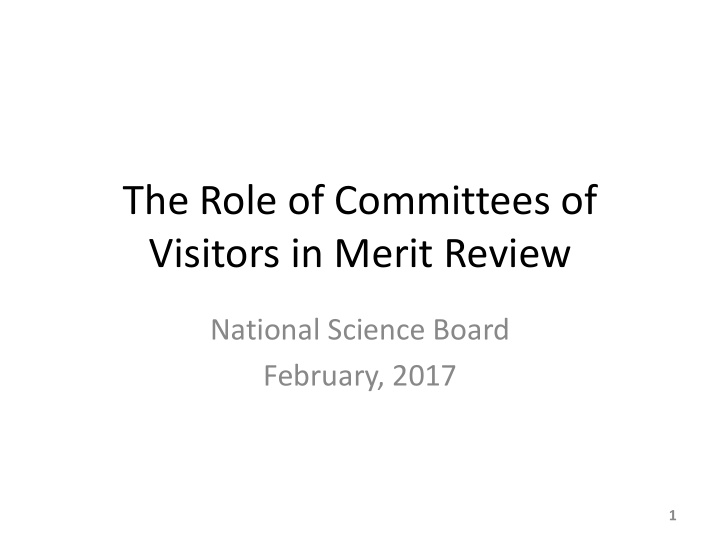



The Role of Committees of Visitors in Merit Review National Science Board February, 2017 1
Advisory Committees Groups of ~ 10 – 20 external experts • Meet twice or more per year • 7 Directorate Advisory Committees • 1 Advisory Committee for the Environmental Research and • Education virtual directorate (ERE) Business and Operations (BFA & OIRM) • Cyberinfrastructure (NSF, Coordinated by OAC) • International Science and Engineering (OISE) • Polar Programs (OPP) • Astronomy and Astrophysics (NSF, NASA, DOE) • High-Energy Physics (DOE, NSF) • Committee on Equal Opportunities in Science and Engineering • (Statutory) Alan T. Waterman Award Committee • President’s Committee on the National Medal of Science • + NSF Merit Review Panels 2
Role of Advisory Committees Academia Industry AC NSF NGOs Government Advisory Committees… Connect NSF with research, education and other • stakeholder communities Provide input on emerging research areas • Help shape NSF priorities • Advise on NSF’s business processes • Subcommittees include Committees of Visitors • 3
The genesis of COVs NSF has used peer review for most of its existence. • 1970s: A desire for more openness and accountability. • NSF developed an External Oversight Plan – now COV. • Made verbatim copies of reviews available to PIs. • Congress recommended that “The National Science Board • should have primary responsibility for the establishment of policies governing peer review.” (1976) NSF submits periodic reports on merit review to the NSB. • 4
Reviewing Merit Review: Committees of Visitors (COVs) Programs that recommend awards are reviewed by an external panel of experts approximately every 4 years. Reports are posted online Most COVs are subcommittees of Directorate Advisory Committees Purpose: (1) Assessment of the quality and integrity of the implementation of the merit review process and program management. (2) Review of portfolio balance, e.g.: Does the program portfolio have an appropriate balance of awards across – disciplines and sub-disciplines of the activity? Is the program relevant to national priorities, agency mission, relevant – 5 fields and other constituent needs?
COV Process Assistant Director / Office Head COV Report Charge …………… ………. …………… …………… ………. 8 – 30 members (FY 2015) Review Analysis NSF 1698765 Intellectual Merit …………… ……. Broader Impacts …………… …….. …………… 6 Recommendation ………..
COV Membership Representatives of disciplines, fields and activities associated with the • program(s) under review – academia, industry, other agencies and laboratories, other potential users. Balanced with respect to topic, types of institutions, and geographic • representation – reflect the heterogeneity of U.S. society. Include at least one member of the affiliated Advisory Committee. • At least 25% of the COV members are not currently serving on any NSF • Advisory Committee and have not been applicants to the program under review for at least 5 years. 7
Most Common COV Comments Merit review process is of high quality • Work of NSF staff is excellent • Programs need more money • Review process should provide advice to declined PIs • Quality of written reviews is variable • PIs and reviewers are confused about Broader Impacts. Reviewers • should receive more guidance about the Broader Impacts criterion Reviewer Orientation Pilot 8
Reviewer Orientation Pilot Goal: To improve the quality of written reviews How? Move orientation: From: after reviewers have written reviews • To: before reviewers write reviews • Orientation: COI/Confidentiality [slides]; Tips on preparing reviews [video] • Program context, additional review criteria, etc. • … : 9
Committees of Visitors Expertise – COV members are recognized experts • Accountability – Provide assurance of integrity and fairness of merit review • Continuous improvement - Contribute suggestions to enhance efficiency • and efficacy of review process 10
Questions? – Dr. Suzanne Iacono (siacono@nsf.gov) – Dr. Steve Meacham (smeacham@nsf.gov) 11
Recommend
More recommend